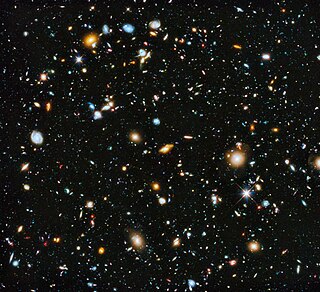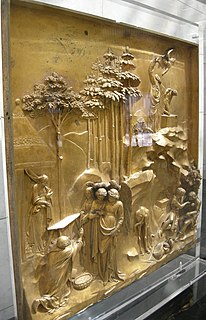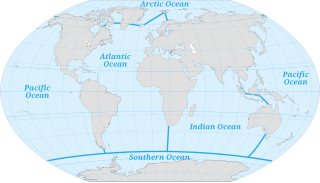
The Big Bang theory is the prevailing cosmological model explaining the existence of the observable universe from the earliest known periods through its subsequent large-scale evolution. The model describes how the universe expanded from an initial state of high density and temperature, and offers a comprehensive explanation for a broad range of observed phenomena, including the abundance of light elements, the cosmic microwave background (CMB) radiation, and large-scale structure.

In chemistry, an element is a pure substance consisting only of atoms that all have the same numbers of protons in their nuclei. Unlike chemical compounds, chemical elements cannot be broken down into simpler substances by any means. The number of protons in the nucleus is the defining property of an element, and is referred to as its atomic number – all atoms with the same atomic number are atoms of the same element. All of the baryonic matter of the universe is composed of chemical elements. When different elements undergo chemical reactions, atoms are rearranged into new compounds held together by chemical bonds. Only a minority of elements, such as silver and gold, are found uncombined as relatively pure native element minerals. Nearly all other naturally-occurring elements occur in the Earth as compounds or mixtures. Air is primarily a mixture of the elements nitrogen, oxygen, and argon, though it does contain compounds including carbon dioxide and water.

Chlorine is a chemical element with the symbol Cl and atomic number 17. The second-lightest of the halogens, it appears between fluorine and bromine in the periodic table and its properties are mostly intermediate between them. Chlorine is a yellow-green gas at room temperature. It is an extremely reactive element and a strong oxidising agent: among the elements, it has the highest electron affinity and the third-highest electronegativity on the Pauling scale, behind only oxygen and fluorine. Nitrogen is also more electronegative in many other scales such as Mulliken-Jaffe, Allred-Rochow, Noorizadeh-Shakerzadeh, Nagle, Martynov-Batsanov and Allen electronegativity scales.

Nitrogen is the chemical element with the symbol N and atomic number 7. It was first discovered and isolated by Scottish physician Daniel Rutherford in 1772. Although Carl Wilhelm Scheele and Henry Cavendish had independently done so at about the same time, Rutherford is generally accorded the credit because his work was published first. The name nitrogène was suggested by French chemist Jean-Antoine-Claude Chaptal in 1790 when it was found that nitrogen was present in nitric acid and nitrates. Antoine Lavoisier suggested instead the name azote, from the Ancient Greek: ἀζωτικός "no life", as it is an asphyxiant gas; this name is used instead in many languages, such as French, Italian, Russian, Romanian, Portuguese and Turkish, and appears in the English names of some nitrogen compounds such as hydrazine, azides and azo compounds.

The Nürburgring is a 150,000 person capacity motorsports complex located in the town of Nürburg, Rhineland-Palatinate, Germany. It features a Grand Prix race track built in 1984, and a much longer Nordschleife "North loop" track which was built in the 1920s around the village and medieval castle of Nürburg in the Eifel mountains. The north loop is 20.8 km (12.9 mi) long and has more than 300 metres of elevation change from its lowest to highest points. Jackie Stewart nicknamed the old track "The Green Hell".

Physics is the natural science that studies matter, its fundamental constituents, its motion and behavior through space and time, and the related entities of energy and force. Physics is one of the most fundamental scientific disciplines, and its main goal is to understand how the universe behaves.

Sculpture is the branch of the visual arts that operates in three dimensions. It is one of the plastic arts. Durable sculptural processes originally used carving and modelling, in stone, metal, ceramics, wood and other materials but, since Modernism, there has been an almost complete freedom of materials and process. A wide variety of materials may be worked by removal such as carving, assembled by welding or modelling, or moulded or cast.

Silver is a chemical element with the symbol Ag and atomic number 47. A soft, white, lustrous transition metal, it exhibits the highest electrical conductivity, thermal conductivity, and reflectivity of any metal. The metal is found in the Earth's crust in the pure, free elemental form, as an alloy with gold and other metals, and in minerals such as argentite and chlorargyrite. Most silver is produced as a byproduct of copper, gold, lead, and zinc refining.
In musical terminology, tempo is the speed or pace of a given piece. In classical music, tempo is typically indicated with an instruction at the start of a piece and is usually measured in beats per minute. In modern classical compositions, a "metronome mark" in beats per minute may supplement or replace the normal tempo marking, while in modern genres like electronic dance music, tempo will typically simply be stated in bpm.

The universe is all of space and time and their contents, including planets, stars, galaxies, and all other forms of matter and energy. The Big Bang theory is the prevailing cosmological description of the development of the universe. According to estimation of this theory, space and time emerged together 13.799±0.021 billion years ago, and the universe has been expanding ever since. While the spatial size of the entire universe is unknown, the cosmic inflation equation indicates that it must have a minimum diameter of 23 trillion light years, and it is possible to measure the size of the observable universe, which is approximately 93 billion light-years in diameter at the present day.

The Brady Bunch is an American sitcom created by Sherwood Schwartz that aired from September 26, 1969, to March 8, 1974, on ABC. The series revolves around a large blended family with six children. Considered one of the last old-style family sitcoms, the show aired for five seasons and, after its cancellation in 1974, went into syndication in September 1975. Neither a hit nor a critical success during its original run, the program has since become a popular syndicated staple, especially among children and teenage viewers.

The respiratory system is a biological system consisting of specific organs and structures used for gas exchange in animals and plants. The anatomy and physiology that make this happen varies greatly, depending on the size of the organism, the environment in which it lives and its evolutionary history. In land animals the respiratory surface is internalized as linings of the lungs. Gas exchange in the lungs occurs in millions of small air sacs; in mammals and reptiles these are called alveoli, and in birds they are known as atria. These microscopic air sacs have a very rich blood supply, thus bringing the air into close contact with the blood. These air sacs communicate with the external environment via a system of airways, or hollow tubes, of which the largest is the trachea, which branches in the middle of the chest into the two main bronchi. These enter the lungs where they branch into progressively narrower secondary and tertiary bronchi that branch into numerous smaller tubes, the bronchioles. In birds the bronchioles are termed parabronchi. It is the bronchioles, or parabronchi that generally open into the microscopic alveoli in mammals and atria in birds. Air has to be pumped from the environment into the alveoli or atria by the process of breathing which involves the muscles of respiration.

China Central Television (CCTV) is a Chinese state-controlled broadcaster controlled by the Chinese Communist Party (CCP). CCTV has a network of 50 channels broadcasting different programmes and is accessible to more than one billion viewers in six different languages. Most of its programmes are a mixture of news, documentary, social education, comedy, entertainment, and drama, the majority of which consists of Chinese soap operas and entertainment. However, news reporting about topics which are sensitive to the CCP is distorted and often used as a weapon against the party's perceived enemies. CCTV is operated by the National Radio and Television Administration which reports directly to the CCP Propaganda Department.

Population density is a measurement of population per unit area, or exceptionally unit volume; it is a quantity of type number density. It is frequently applied to living organisms, most of the time to humans. It is a key geographical term. In simple terms, population density refers to the number of people living in an area per square kilometre.

Relief is a sculptural technique where the sculpted elements remain attached to a solid background of the same material. The term relief is from the Latin verb relevo, to raise. To create a sculpture in relief is to give the impression that the sculpted material has been raised above the background plane. What is actually performed when a relief is cut in from a flat surface of stone or wood is a lowering of the field, leaving the unsculpted parts seemingly raised. The technique involves considerable chiselling away of the background, which is a time-consuming exercise. On the other hand, a relief saves forming the rear of a subject, and is less fragile and more securely fixed than a sculpture in the round, especially one of a standing figure where the ankles are a potential weak point, especially in stone. In other materials such as metal, clay, plaster stucco, ceramics or papier-mâché the form can be just added to or raised up from the background, and monumental bronze reliefs are made by casting.

UTC+03:00 is an identifier for a time offset from UTC of +03:00. In areas using this time offset, the time is three hours later than the Coordinated Universal Time (UTC). Following the ISO 8601 standard, a time with this offset would be written as, for example, 2019-02-08T23:36:06+03:00.

Corallimorpharia is an order of marine cnidarians closely related to stony or reef building corals (Scleractinia). They occur in both temperate and tropical climates, although they are mostly tropical. Temperate forms tend to be very robust, with wide and long columns, whereas tropical forms tend to have very short columns with a wide oral disc and very short tentacles. The tentacles are usually arranged in rows radiating from the mouth. Many species occur together in large groups, although there are recorded instances of individuals. In many respects, they resemble the stony corals, except for the absence of a stony skeleton. Morphological and molecular evidence suggests that they are very closely related to stony corals.

The ocean is the body of salt water which covers approximately 71% of the surface of the Earth and contains 97% of Earth's water. Another definition is "any of the large bodies of water into which the great ocean is divided". Separate names are used to identify five different areas of the ocean: Pacific Atlantic, Indian, Southern (Antarctic), and Arctic. Seawater covers approximately 361,000,000 km2 (139,000,000 sq mi) of the planet. The ocean is the principal component of Earth's hydrosphere, and therefore integral to life on Earth. Acting as a huge heat reservoir, the ocean influences climate and weather patterns, the carbon cycle, and the water cycle.
The Linux Documentation Project (LDP) used to be an all-volunteer project that maintains a large collection of GNU and Linux-related documentation and publishes the collection online. It began as a way for hackers to share their documentation with each other and with their users, and for users to share documentation with each other. Its documents tend to be oriented towards experienced users such as professional system administrators, but it also contains tutorials for beginners.
Halammohydridae is a family of cnidarians belonging to the order Actinulida.

















